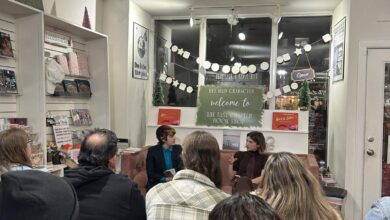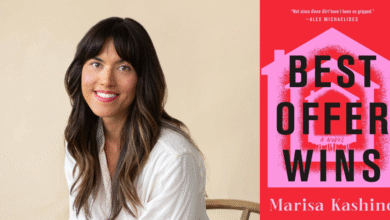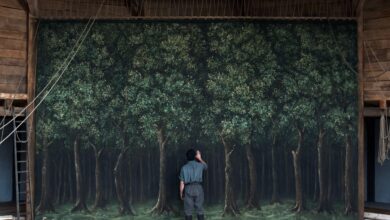From seed of a scene, Helen Starbuck creates a full-blown mystery

Helen Starbuck is a Colorado native, a former operating room nurse, editor, and an award-winning author. When not writing, you can find her ballroom dancing, gardening, traveling, reading books with suspense-filled situations, researching topics that would probably get her arrested if she were a murder suspect.
SunLit: Tell us this book’s backstory. What inspired you to write it? Where did the story/theme originate?
Helen Starbuck: I love mystery and romantic suspense novels like those of Tami Hoag, Sandra Brown, and Jane Harper, and what I especially enjoy are the settings in which these authors tell their stories.
As a Colorado native, my books are all set in various places in Colorado. Often scenes come to me that inspire a novel. The entire plot doesn’t necessarily accompany those scenes, but they give me a starting point. The scene that popped into my head for “The Killer Without A Face” was of a woman stranded at the side of a mountain road in an old truck that had died on her.
It’s late at night and she has no cell phone service or nearby town to walk to. I could feel her frustration and desperation. Scenes like that then prompt questions, what is she doing there, why is she alone, why does the situation frighten her? All those eventually lead to the plot unfolding.
SunLit: Place this excerpt in context. How does it fit into the book as a whole? Why did you select it?
Starbuck: The scene I chose gives the reader a bit of background to explain how Dani Calderwood is drawn into a dangerous situation that ends up with her fleeing Denver to elude the police and a killer, both of whom think she can identify him. Having caught only a glimpse of him, she can’t ID him, but they don’t know that.
UNDERWRITTEN BY
Each week, The Colorado Sun and Colorado Humanities & Center For The Book feature an excerpt from a Colorado book and an interview with the author. Explore the SunLit archives at coloradosun.com/sunlit.
SunLit: Tell us about creating this book. What influences and/or experiences informed the project before you sat down to write?
Starbuck: I love stories with brave, resourceful women challenged by circumstances that are out of their control or experience. And I love immersing myself in physical settings that are new to me. I love learning about new places and I love being entertained by tight plots and surprise endings.
I also enjoy (although it’s not required) a bit of romance. All that informs my writing and I love sharing glimpses of Colorado to readers who may not be familiar with it. Readers who know Colorado say they enjoy recognizing familiar locations.
SunLit: What did the process of writing this book add to your knowledge and understanding of your craft and/or the subject matter?
Starbuck: Every book I write (“The Killer Without A Face” is book number eight) adds to my understanding of writing and I hope my skill as a writer. Stephen King says that you have to be a reader to be a good writer, and I agree. I’ve always read extensively and each book adds to my understanding of the skills required and helps me sharpen my writing.
Researching the books is fascinating and I always learn something new. I have a wonderful team of beta readers who help me with that and with this book, in particular, they helped me locate a spot in the high country of Colorado that worked perfectly for the setting and (because one lives in such a small town) kept my depictions of the town and other issues accurate.
“The Killer Without a Face”
Where to find it:

SunLit present new excerpts from some of the best Colorado authors that not only spin engaging narratives but also illuminate who we are as a community. Read more.
SunLit: What were the biggest challenges you faced in writing this book?
Starbuck: My experiences of small mountain towns are as a visitor, not a resident, so feedback from two people who have lived or currently live in one was imperative. The geography, the routines of a town like that, and the weather were issues I had to keep checking on. The other challenge was how to allude to but not reveal the killer until the end of the book. That’s always a challenge in any mystery/suspense novel.
SunLit: What’s the most important thing — a theme, lesson, emotion or realization — that readers should take from this book?
Starbuck: The theme is that we have the ability to survive and thrive when difficulties arise, but it requires us to pay attention to what we need, not always what others want or need. It requires us to step outside our familiar world.
I wanted to explore the complex structure and relationships within a family affected by addiction and abandonment. I have the utmost admiration for those who weather these situations—both the addict and the people who love them—and emerge whole.
It’s not easy. I wanted to explore the conflicted, exhausting, love/hate relationship we often have with addicted family members or friends. The need to sacrifice your life for them versus the wish to escape what Dani describes as “the millstone around her neck” is always a struggle.
I wanted to show that forced into a desperate situation, Dani Calderwood must think on her feet, protect herself, and come to terms with what has happened to her sister. I wanted there to be a light at the end of that tunnel and watch her get there.
SunLit: How did you create the character of Jess Walker and how does he help Dani Calderwood grow as a character?
Starbuck: One of the goals of any good story, in my opinion, is characters must change/grow in some way. The plot and other characters should help move them in that direction. In real life we change and grow based on our experiences and how open we are to making necessary changes. I think that’s important in fiction as well.
One of Dani Calderwood’s main issues is trust. Her experiences with her sister have made it extremely difficult to trust other people and in response she has kept everyone at a distance. In the course of this novel, she has to trust that there are people who want to help her survive if she’ll let them. Jess is one of those people.
I wanted him to have his own trust issues and vulnerabilities so he has experienced a serious injury to his leg that resulted in a medical discharge from the Marines. It causes him to limp and embarrasses him. He doesn’t like discussing his service or his injury, so he has built some walls around that. He moved to the small town Dani is stranded in to get away from what he describes as the “chaos of Denver” after his rehabilitation is done. He likes the isolation and the small community and as the town’s bartender he is a focal point for the community. He’s a good person who can keep his eyes and ears open and help Dani.
I like characters who aren’t perfect. I think they’re far more interesting and believable than those who have all the looks, brains, money, and skills and no defects. Jess is a bit gruff and has learned over time to open up to the people in town and become part of it. He sees in Dani many of the issues he’s dealt with and wants to help her but also gets quite frustrated with what he sees as her inability to accept that not everyone has an ulterior agenda.
SunLit: Tell us about your next project.
Starbuck: I write “The Annie Collins Mystery Series,” which is set in Denver and has a main character who is an operating room nurse. In the first book, “The Mad Hatter’s Son,” Annie is dragged into investigating an old friend’s illness and death. That triggers a curiosity about situations that crop up and reluctantly, homicide Detective Alex Frost lets her help him investigate them. I am writing book five in the series, which will probably debut sometime before the holidays this year.
My other work in progress involves one of the major characters in the series—Detective Frost. He has become a favorite of readers and I have had many requests for a book about him. I’m currently working on one that takes place early in his career as a police officer and explains how he ends up in homicide. It’s set in 1984, so it’s required some research to keep it accurate to that time period.
A few more quick questions
SunLit: Which do you enjoy more as you work on a book – writing or editing?
Starbuck: I like both actually. Editing ends up simply being more in-depth writing.
SunLit: What’s the first piece of writing – at any age – that you remember being proud of?
Starbuck: My teenage stories about the Beatles.
SunLit: What three writers, from any era, would you invite over for a great discussion about literature and writing?
Starbuck: Daphne DuMaurier, Kate Quinn, Tami Hoag
SunLit: Do you have a favorite quote about writing?
Starbuck: “Your intuition knows what to write, so get out of the way.” – Ray Bradbury
SunLit: What does the current collection of books on your home shelves tell visitors about you?
Starbuck: That I love historical fiction, mystery, crime, suspense, and the classics and that I read a lot.
SunLit: Soundtrack or silence? What’s the audio background that helps you write?
Starbuck: Music often triggers ideas, but I can’t write when it’s playing, it’s too distracting.
SunLit: What music do you listen to for sheer enjoyment?
Starbuck: I am all over the place, rock and roll, rhythm and blues, country western (contemporary not the older music), Latin music, Anything that has a catchy melody or intriguing lyrics.
SunLit: What event, and at what age, convinced you that you wanted to be a writer?
Starbuck: Miserable in high school, I discovered that writing and reading helped me escape into a world that was far more interesting and satisfying. As I like to say, if you don’t like life as it is, write a new story.
SunLit: Greatest writing fear?
Starbuck: That I’ll run out of ideas.
SunLit: Greatest writing satisfaction?
Starbuck: My books have won awards and one, “The Burden of Hate” received a starred Kirkus Review. In addition, readers have given them great reviews and often contact me to tell me how much they enjoyed reading one of my books.
Source link




